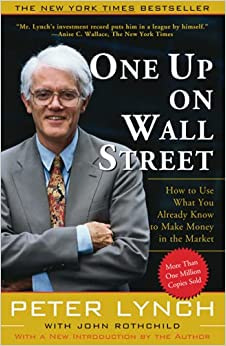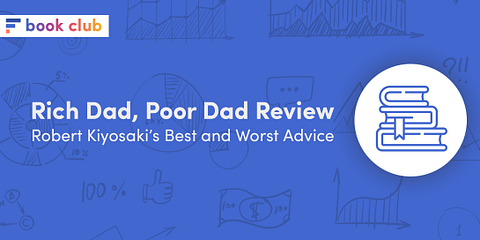Peter Lynch’s “One Up on Wall Street” is a classic book on investing that retains relevance long after its publication. In this “One Up on Wall Street” review I’ll look at the key concepts of the book and try to give you a framework to decide whether the book will be useful for you. We’ll also point out actionable suggestions from the book that you can use to develop your investment strategy.

How to Use What You Already Know to Make Money in the Market
This long subtitle was also the subtitle of Peter Lynch’s legendary book “One up on Wall Street”, published in 1989. Pretty much like the rest of the book, the title says it all and is very easy to understand. The style of writing and the simplicity of its concept makes it a great book for beginner investors.
Key Idea #1: You know More Than Wall Street Pros Ever Will
Peter Lynch had an atypical profile on Wall Street. In college, he mostly studied history, psychology, and political science. His investing returns were atypical as well. While 60% of money managers struggle to just beat the indexes, Peter Lynch achieved a 29.2% average gain. According to him, having a more eclectic background played a big role, “as investing is an art, not a science”.
He consequently had a poor opinion of business school and academic economics. For example, speaking of Peter deRoetth, a friend of his with a brilliant stock picking record, Lynch said:
The secret of his success is that he never went to business school. Imagine all the lessons he never had to unlearn.
Peter Lynch
He argues that the common people know a lot about the products they consume, the shops they visit, and the restaurants where they eat. He gives an example: 10 pairs of jeans at The Gap cost $180 in 1976. Instead, you could have bought 10 shares of Gap stock at its IPO price, $18. This would have turned into $4,672.50 by 1987.
In addition to the possible advantage as a consumer, working people might also have a professional advantage. A plumber will know the best pipe supplier. Engineers see the trends in their industry in real time. Such deep professional knowledge is simply out of reach for hedge fund managers who have little exposure to the real economy, no matter how many financial reports they read.
Key Idea #2: Wall Street is Slow and Has the Wrong Focus
Wall Street fund managers don’t like to buy unless they have analysts covering a stock, and they prefer to see other funds buying the stock before they move. Group thinking driven by personal career risk makes Wall Street slow to react to great, growing businesses.
Wall Street and economists focus on a lot of macroeconomics, like interest rates, inflation, the Fed, etc. Lynch never paid attention to these and admitted he had no idea how “the market” was doing. He knew the stocks he owned and saw himself as owning parts of businesses, not a part of the stock market.
Lynch also points out that mundane products can make for great stock. Complexity and technology can make for financial reports and career plans that look great, but there’s a huge risk in looking for complexity for its own sake.
There seems to be an unwritten rule on Wall Street: If you don’t understand it, put your life savings into it.
Peter Lynch
Key Idea #3: How Can Retail Investors Handle the Risk of Stock Picking?
Lynch acknowledges that stocks are on average both more profitable and riskier than bonds. He also does not believe there is a clear boundary between investing and speculating, only shades of grey. In his opinion, the only way to mitigate risk is to know the company and its products. This is why investing in what you already know well makes a lot of sense.
He also recommends retail investors ask themselves 3 questions:
- Do I own a house?
- Do I need the money?
- Do I have the personal qualities to succeed with stocks?
The first two are to help you stay rational about money and make good decisions.
Regarding personal qualities, he thinks a good investor should have:
- patience
- self-reliance
- common sense
- tolerance for pain
- humility
- persistence
- open-mindedness
- flexibility
- willingness to do independent research, admit mistakes, and ignore general panic
This is a long list. It is also an honest one and the core of the book’s message.
This book is not trying to say everybody can be a great investor. It says that anybody can do it, with the right method and temperament. Investment success doesn’t come from education, IQ or occupation.
Stock Categories
Different companies have different profiles. Lynch distinguishes 6 categories:
- Slow growers.
- Medium growers.
- Fast growers.
- Turnarounds: depressed companies poised for a comeback.
- Cyclicals: subject to regular rise and falls.
- Asset plays: own something valuable that Wall Street has missed.
Each type has its own qualities, and you’ll need to assess those once you have classified the company.
The Perfect Stock
Lynch gives his ideal stock profile. These are ideas investors can or modify to start looking for their own picks:
- It has a boring or even ridiculous name
- Its business is dull (like bottle caps) or even disgusting (trash collection, intestines for hot dogs, etc.).
- It’s a spin-off (as large investment firms sell the stock, depressing its price)
- It’s depressing (funeral services, alcohol)
- Its industry is not growing. No one tries to compete there, the best company can consolidate the market.
- It has a niche (reduce competition).
- People have to keep buying its products.
- Technology cut its costs.
- Insiders are buying.
There’s a clear pattern here. Lynch prefers to avoid trendy stocks or stocks that have been bought up due to hype. He likes hated sectors. There are points here that we could dispute, but overall the idea of buying ignored companies is reasonable.
What Stocks to Avoid
Lynch also suggests some characteristics that he sees as red flags to avoid.
- The next big thing. The next IBM (Amazon or Tesla today?) is probably not going to succeed as much as IBM. Such enthusiasm can even mark the beginning of trouble for the original to which it is compared to.
- “Diworseification”: mixing diversification and worsening, the word illustrates when companies enter new markets for no good reasons. A solid niche is better than multiple failing products.
- Dependents. Companies that rely on one client or a small number of clients for a large part of their business are vulnerable.
Again, these are not the only things you’ll want to avoid in an investment, but if you see than you may want to take a closer look.
Earning and Cash Flows
Retail investors need to put some legwork to gain deep factual knowledge about a company. This means reading the annual reports, figuring out how earnings can grow, knowing the free cash flow, how inventory is accounted for, pensions fund liabilities, competitive position,etc. People who aren’t willing to put in this effort should avoid stock picking.
The Story
Before investing, you should be able summarize your investment thesis in a 2 minute story about the stock. Include what the company does, how can it grow, why the stock is mispriced, and other key features.
That story should be regularly re-checked in light of the latest developments. Reassess your story if the company enters into a more mature, slower growth stage of its life, makes a major acquisition, or undergoes another major change..
Portfolio Management & Trading
We’d have to double the size of this review to do justice to this chapter of the book. Lynch gives solid advice on when to rebalance a portfolio according to the industry category a stock is in. He also explains his view on diversification and how many stocks an investor should hold.
Overall, he recommends a conservative strategy (long-term holding with multiple industries and company profiles) with a concentrated approach of 10-50 stocks.
The 12 Silliest (and Most Dangerous) Things People Say About Stock Prices
I like this concluding chapter because it is somewhat amusing to read and contains a lot of timeless truths (I shortened some of them):
- If it’s gone down this much already, it can’t go much lower.
- You can tell when a stock has hit bottom.
- If it’s gone this high already, how can it possibly go higher?
- It’s only $3 a share, what can I lose?
- Eventually, it will come back.
- It can’t get worse than this.
- When it rebounds to $10, I’ll sell.
- Conservative stocks don’t fluctuate much.
- It’s taking too long for anything to ever happen.
- I lost a lot of money because I didn’t buy it.
- I’ll catch the next one.
- The stock is up/down so I must be right/wrong.
You’ve probably heard all of these and a few more, and if you catch yourself thinking along these lines, it’s time to reassess.
Conclusion
I think One Up on Wall Street is a great book for retail investors. On one side, it is motivating, witty, and even funny. It gives a beginner investor the right mindset and the right warnings. Every idea is clearly illustrated by easy-to-understand real-world examples taken from Lynch’s extensive investing experience.
On the other side, it is brutally honest. It does not shy away from what makes investing difficult. The central idea is that investing can be for anybody, but is certainly not for everybody. It also does not avoid “dry/hard” topics, like accounting metrics. These discussions also come with clear and actionable explanations on how to use these metrics to mitigate risks.
I think the perfect reader for this book is someone without a background in business/investing, but with a lot of motivation or interest. The book takes an educational approach and is rather light in tone and easy to read. It provides a solid template for a successful value investing strategy IF you are willing to work for it. Lynch’s approach is time-consuming, and he was known as a workaholic. His approach is best for investors who are passionate about markets and investing.











